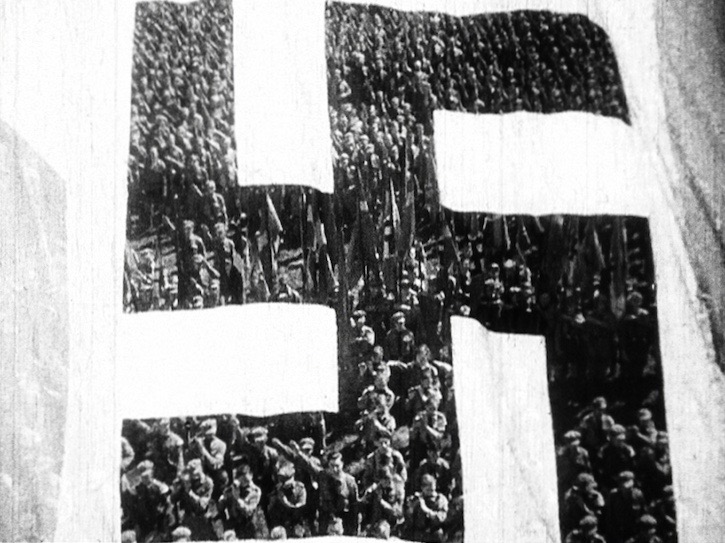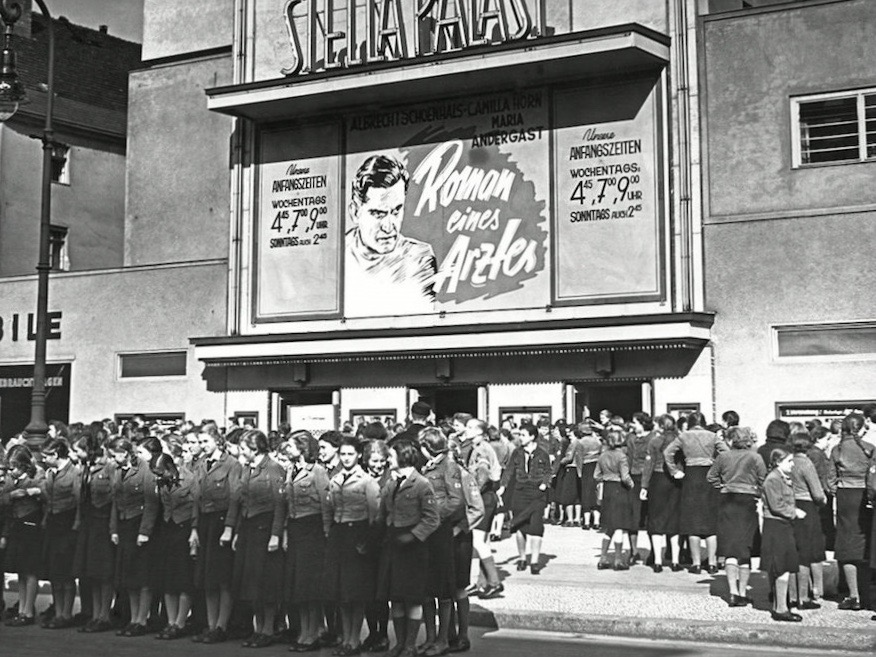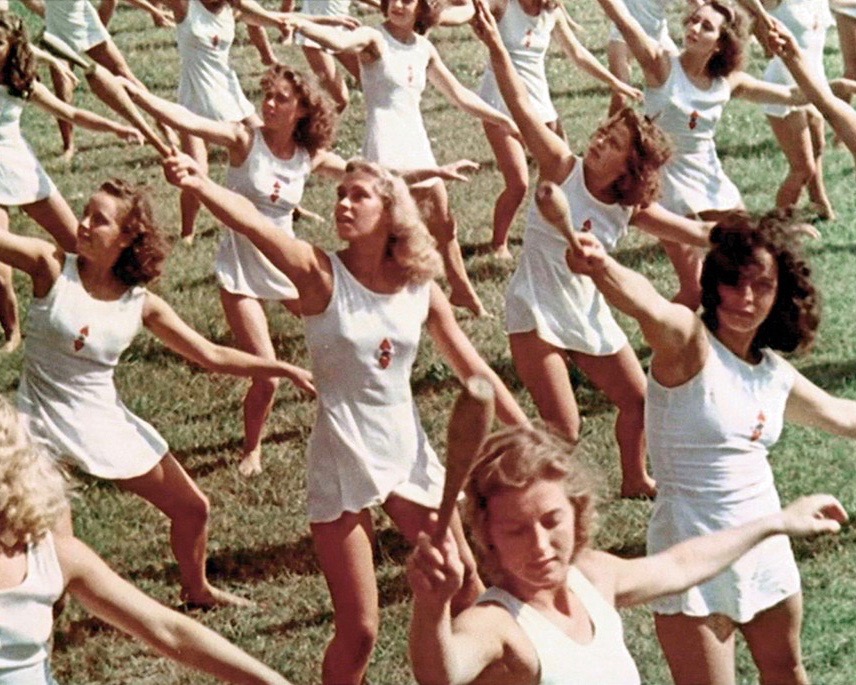When a historical nightmare occurs it can distort every facet of society, in particular the arts. Artistic expression is molded by the tides of events. If a society goes completely mad, its artistic processes will be a reflection of the disease. This is ever so evident in the evolution of fascist societies. Rüdiger Suchsland’s brilliant, unnerving yet captivating new documentary, Hitler’s Hollywood, is a work of dark reverie and critical study. It challenges the viewer to ponder the very meaning of the word “beauty,” and to wonder in disturbed awe if fascism can indeed produce beautiful works. Moments in this documentary are indeed so luminous that the spectator cannot help but drink in the imagery, even if we are aware that it is all merely a veil for horrors.

Hitler’s Hollywood is a kind of sequel to Suchsland’s previous work, From Caligari to Hitler, which was based on the seminal book by critic Siegfried Kracauer. That film was a study of German cinema during the Weimar Republic, digging into the psyche of titles like M, Metropolis and Nosferatu to dissect the state of a society preparing itself for Nazism. In this new film Adolf Hitler has already taken power, the economic crisis of the 1920s has receded, anti-Semitism is becoming a national philosophy, and fascism has bred a new culture of utopian hopes. The public is therefore ready for a cinema that will crystalize its daydreams. Of course one must have control over the dream factory itself. As renowned artists such as Fritz Lang and Marlene Dietrich fled Germany for Hollywood, those who stayed behind would form part of UFA, the only major film studio left standing after the Nazi government nationalized it following the shutdown of everyone else. Propaganda minister Joseph Goebbels proceeded to create a fascist twin to Hollywood, commissioning the production of every major genre of the period, except horror films and crime movies (it would have been a tad too close to mirroring the actual regime).
Suchsland has blown the dust off many of the films made during this period, even into the final months of World War II. He presents them here like a dreamlike montage, a scroll of desires and fantasies. Epic moments, faces beautifully framed and colorful sets rush across the screen with Udo Kier providing a keen and insightful narration. At times the figures Suchsland profiles are as tragic as the roles they played. Ilse Werner was a gorgeous siren with real charisma, but her father forbade her to work outside of the Third Reich. Georg Wilhelm Pabst, a highly talented director, was blocked from leaving Germany out of sheer bad luck. Forced to stay, he made films such as the medieval period piece Paracelsus, where subversive ideas are carefully hidden within the story. Yet Nazi films with hidden protests were the exception, not the rule. Most of the cinema of the period gladly celebrated fascism’s ethos, its blood and land occultism and worship of death.

The marriage between art and reaction is nothing new. In the 20thcentury one of the earliest orchids to announce the birth of a fascistic form of art were The Futurists. Even now, the Futurist texts provide a clear understanding of how the seeds of fascist thought can be metamorphosed into a witch’s brew of poetry. The founder of the movement, the Italian Filippo Tommaso Emilio Marinetti, produced a body of critical writings which glorify speed, technology, war and nationalism. In his The Foundation and Manifesto of Futurism, Marinetti proclaims, “we glorify war, sole cleanser of the world.” More eloquent exclamations would announce, “let’s kill off the moonlight” and “Yes, our very sinews insist on war and scorn for women.” Futurist poetics glorified masculinity and scorned the warm ideals of romantic love, for to live meant to take, to destroy the old world and create something terrible and new. Anarchists and Marxists were condemned as delusional romantics, fighting for a world that could never be. Interestingly enough, Marinetti was never an anti-Semite, and once Benito Mussolini took power he encouraged the Duce not to carry out ethnic cleansing against the Italian Jewish population. Instead Marinetti’s philosophy was a kind of pure right-wing romanticism, a radical right-wing vision which ran counter to the more leftist, anarchic tendencies of the Dadaists and later Surrealists. Yet Marinetti shared with Andre Breton and Hugo Ball a desire to express ideas through a subversive distortion of the world. His The Futurist Cookbook presents “recipes” for meals such as ice cream on the moon, but with a nationalist spirit hidden in-between the lines. For Marinetti war itself was an art form, producing an alluring, fiery glow. “War is beautiful because it initiates the dreamt-of metallization of the human body. War is beautiful because it enriches a flowering meadow with the fiery orchids of machine guns,” wrote Marinetti, in prose Steve Bannon dreams he could conjure.

It is with the ascendance of fascism to absolute power in Germany that we see the full realization of a fascist cinema. The line between the Futurists and the even more toxic, racist creations of Nazi filmdom, is captured in Suchsland’s narration when he describes the Third Reich as a movie in itself, directed by Joseph Goebbels, overseen by Hitler. Worn out by years of chaos and political street fighting, the German masses were swept away by the Fuhrer’s pageantry and sense of strict, marching orderliness. But it was an operatic militarization, complete with torchlight marches and Wagnerian music. German cinema provided the candy-colored escape within this totalitarian reality. Suchsland reveals how after merely three days after taking power Hitler attended the premiere of a submarine war movie in which sailors gladly die for the fatherland. In Nazi cinema death is glorified as the ultimate, heroic sacrifice for the nation state. Propaganda is channeled through drama. In another early film, Hitlerjunge Quex, a young boy named Quex rebels against his Marxist, working class parents and local, debauched Communist youth, preferring to find solace in the conservative ethos of a Nazi youth camp. The boy meets a tragic death at the end, but his dying moment transitions into columns of marching troops. One death becomes legions of marching supermen ready to conquer the world.
The most insidious and perversely alluring films in Hitler’s Hollywood lack an open, militarized spirit. They are instead melodramas, epic period pieces and even tap-dancing musicals. Goebbels and Hitler both enjoyed American cinema in private, and they sought to replicate the aesthetics of American entertainment with a Nazi tinge. It Happened One Night was remade into a lighthearted parable meant to portray the Reich’s inhabitants are cheerful and vivacious. Films like Regine were the equivalent of feel-good date flicks, but hiding a fascist heart. Irony was not common in Nazi cinema. How could it be? Totalitarian systems depend on a lack of self-humor or cynicism.

The opening scene of the documentary is a clip from a Sherlock Holmes film in which the detective is merrily singing and whistling while taking a bath. As the narration hints, the purpose of this sort of filmmaking is to numb the senses of the spectator, to subconsciously inject a perception of reality. The color films of this period are glorious and look like dreams made flesh. Blonde, blue-eyed women fall in love, men await death with pride. Hannah Arendt and Susan Sontag are quoted in the film, as well Kracauer, on how cinema as propaganda appeals to the desire of the masses to shut away from reality and sleepwalk. If there was any sense that the Third Reich was morally reprehensible, or that Hitler was preparing his society for war, such qualms were gently put to rest by the fantastical drug of these films. Editors were specifically instructed to use many dissolves, soft fades and wipes, to give the films an even more hallucinatory texture. Indeed, watching this documentary on the big screen seems to cast away time itself. One is swept in a current of images and music, lost for a moment in a fascist dreamscape. There is even an epic, Lawrence of Arabia-style film featured, amid burning sands and riding adventurers.

Hitler’s Hollywood is also a startling chronicle of artistic infamy. One of the documentary’s most stunning revelations is that Ingrid Bergman had a starring role in a Third Reich picture, The Four Companions. She would later try desperately to have any memory of the film erased, her only comment after the war being that she once turned down an offer to have tea with Goebbels. Bergman was not the only Swede to make films with UFA at this time, and indeed, Goebbels liked bringing in international (of Aryan stock to be sure) names to give Nazi cinema a sense of true, broad appeal. Douglas Sirk, who would later craft the definitive look of technicolor melodramas in Hollywood, also worked for UFA at this time, producing melodramas silky in their look. These were names who along with personas such as the conductor Herbert Van Karajan, collaborated with the regime out of an almost cynical sense of careerism as opposed to actual, fascist ideology. It was convenient to work, and until the bombs began to fall you could be oblivious to the gathering storm.

But it is impossible the escape the venomous strain of a particular system of thought. Possibly the most notorious film from this period is Jud Suss, an openly anti-Semitic period drama, set in the 18thcentury. As explained by the documentary, it practically destroyed the career of actor Ferdinand Marian, whose reputation would never recover from its stark portrayal of a corrupt, Jewish treasurer who schemes and seduces in the 1700s. This, along with another film, The Rothschilds, captures the overt racism in fascist art.
In The Rothschilds, rich Jews draw a Star of David to describe their plans for international control, from London to Jerusalem. Suchsland contrasts these scenes with Hitler himself giving a speech proclaiming that international financial Jewry will soon be crushed. There is a fine line between fiction onscreen and its manifestation as dangerous ideals in real life. Suchsland is very much provoking the viewer to consider how this is not a freak event from the distant Nazi past. Racial and social distortions promoted by media with a certain ideological bent will influence thought processes. When the president calls sectors of a populace “animals,” he is projecting a specific idea and perception into the minds of his followers.
We live in an era obsessed with imagery and the perfection of the body. Even if we surely do not identify as Nazis, there is an unnerving feel while watching Hitler’s Hollywood that certain blemishes seem to be a natural outgrowth of capitalist society. In the Third Reich the ultimate cinematic expression of the regime came in the propaganda films of Leni Riefenstahl. Her Triumph of the Will, infamous for its staging of Nazi party rallies as messianic ritual in worship of Hitler, is well known. But in Suchsland’s documentary it is her film of the 1936 Munich Olympics, Olympia, has produces a more insightful, disturbing effect. In its appeal to the senses through the editing and emphasis on the perfect, idea Aryan body, it turns physical perfection into an occult object. In this section Susan Sontag is quoted as confirming that Riefenstahl’s cinema appeals to the modern viewer, whether we admit to it or not, because it appeals to the primitive tastes and objectifications still rampant in modern society. Even if we do not adhere to the fascist principles of war as hygiene of the planet, or the rise of a herrenvolk, we currently place physical perfection on a pedestal which can almost be called religious. Suchsland seems to warn that once we begin there, then there is no telling what can follow.
Interestingly enough, Nazi cinema had a strange, feminist angle to its storytelling. Women are portrayed as strong, independent caretakers of the Reich. In promoting the ideal of the woman as the breeder of the coming master race, and in condemning the weakness of cowardly men, Nazi cinema adores the idea of the Aryan woman as a Valkyrie ready for battle. In one grand drama, a dying wealthy man falls for a beautiful young blonde who rides a white horse and practices archery. In another film a soldier fighting in Russia receives letters from his beloved, devoted to wait for him as he crushes the barbaric hordes.

As World War II erupted and soon the country found itself nearing an abyss, Nazi cinema as described by Suchsland begins to take on a bizarre, almost colorfully demented air. Musicals and romances bursting with color are produced ever more readily, in some cases featuring dancers in Latin garb. Masked balls are celebrated with decadent designs, as if society is partying towards the apocalypse. But perhaps the most astonishing act of cinematic prophecy during this period is Herbert Selpin’s Titanic. Indeed, before James Cameron the Nazis had already told the tale of the doomed ship, complete with grand special effects displaying luxury overflowing with crashing waves. In this version it is not an iceberg that dooms the vessel, but the machinations of evil capitalists, Brits and Jews. Made as Stalingrad proved to be the cemetery for Hitler’s dreams of conquering the Soviet Union and winning the war, even Goebbels could not help but notice the disturbing aura of the film’s subtext. The film was only shown in occupied countries, never inside Nazi Germany itself. It is a cinema of disaster, manifesting the idea of a coming collapse. Another epic of the period, dramatizing the Napoleonic wars, with a cast of hundreds of thousands, also roars across the screen as a symphony of fire and blood.

Hitler’s Hollywood glows on the screen not merely as a time capsule. A student of Kracauer, Suchsland’s collection of raging bonfires, glassy eyes, red lips and screaming warplanes serves as a universal template. If this is what the cinema of the Third Reich reveals about the subconscious dreams and nightmares of a society during that particular chapter in history, what does our cinema (and television) reveal about us today? What does our consumer society say about our state as people? We are intoxicated by fantasy and visual effects, violence so absurd it numbs us to what real bloodlust is. War clouds gather in the east, campuses are hunting grounds, but we prefer to consume media that tells us everything is ok, and strong, caped heroes will banish away evil. Our anxieties about the world and possible cataclysm are alleviated by movies where the destruction already takes place as savage storms and alien threats obliterate cities. Lest we doubt the foreign policy of our system, war films tend to cast the armed forces in a spotless, heroic glow, with their Middle Eastern opponents as rambling (un-subtitled) specters.
It would be vulgar of course to claim what we consume now is a full recycling of the ideals of the Third Reich. But Suchsland is exploring the past while challenging us to apply his method to the present. He is implying that we will better understand who we are, and where we are going, if we awaken from our trances and look upon our own dreams and nightmares.
[paypal_donation_button]
Alci Rengifo is Cinematics Editor at Riot Material and a freelance writer based in Los Angeles. Mr. Rengifo frequently contributes to the Los Angeles Review of Books, Entertainment Voice, and the East LA monthly Brooklyn & Boyle.




I find this article intriguing but unfortunately when I find an historical inaccuracy I generally stop reading because it calls the entire work into question. Your identification of Hitler and the Nazis as “fascists” is historically inaccurate. Fascism was an Italian political movement created by Benito Mussolini and Giovanni Gentile. The Nazis were SOCIALISTS. They were first misidentified as Fascists by Josef Stalin who wished to separate the National Socialists (Nazis) from his own movement which was international in scope and directly controlled by Moscow. It worked. The leftist American press eagerly adopted this misnomer as a way to distance themselves in the public mind from the horror that was taking place in Germany. The Word NAZI is a shorter version of the party’s name which was, “NAZIonal Socialistiche Deutche Arbiter Partie. In English that is National Socialist German Worker’s Party. But, the best way to see what Hitler and his small group of followers were really about is to look at what they did once they came came to power. The policies of the Third Reich are virtually the exact same policies being sold to American people today by the socialists right here at home. The only difference between the German version and ours is that we have substituted the word Republican for the word Jew.